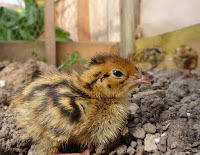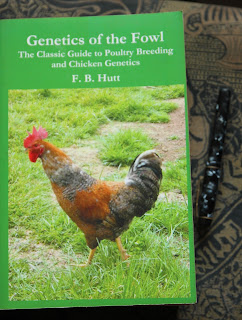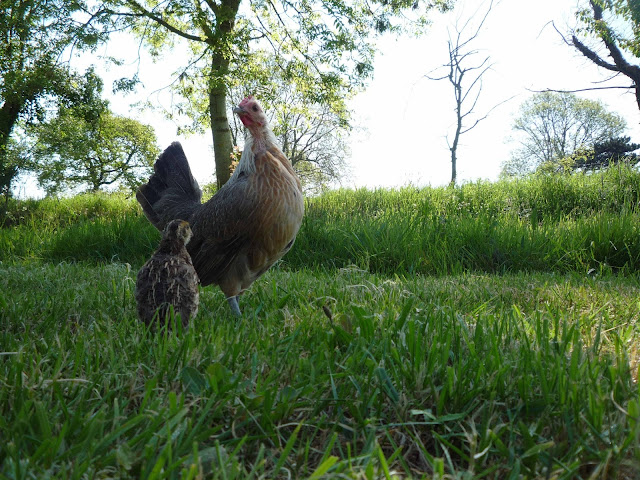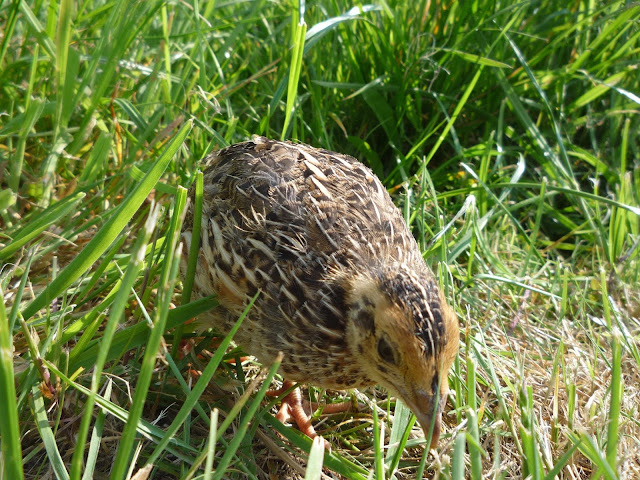In the pages of this site, I write mostly on practical issues and as
'The Holistic Hen', I do always hope that I am looking at the whole
bird. Thus plumage colour is important but just for once I'm going to to
be a frivoler and concentrate on aesthetics. There are so many wonderful words to describe a collection of creatures and probably a 'murder of crows' and its antithesis a 'charm of finches' are my firm favourites. Even so, these are followed swiftly by an 'abominable sight of monks', a 'superfluity of nuns' and a 'busyness of ferrets'. Furthermore, with this week's addition of five, I feel well on the way to announcing that I have achieved a veritable 'drift' of coloured quail.
I thought I'd just showcase some of the colours I have at the moment and in this first part, I'm showing the most popular and common colours of quail, in male and female adult, juvenile and chick form. In the following two articles I'll show the more unusual colours. As some of these are a first for me, I haven't obviously as yet any pictures of chicks - hopefully that will be a part four to this article! It certainly has been quite difficult to identify some of them, so another reason for writing this article is in the hope of clarifying what I believe to be the correct descriptions. If anyone reading this finds I have incorrectly identified my quail, then please do let me know.
Sir John Sebright, friend and fellow explorer with Charles Darwin, is mentioned by the latter in Chapter One of the Origin of the Species:
'That most skilful breeder, Sir John Sebright, used to say, with respect to pigeons, that ‘he would produce any given feather in three years, but it would take him six years to obtain head and beak.’Having dipped into F.B. Hutt's weighty tome and seminal work and in particular, the chapters on feathers and colours, that seems pretty good going to me.
If you want to get into the 'science' of colour then I would recommend this work, though not as light reading! I bought this book some years ago or rather it was bought for me in the US At the time we were living in the UK, where it was out-of-print but now it's available. It's complicated, as with anything concerned with genetics but it's an absorbing and useful reference book. It helped me greatly in explaining how and why incredible, gloriously coloured Frizzles kept turning up in my flock!
Pharaoh or Brown
Below is the film 'The Coulours of Quail - The Pharaoh' and below that is a female (note the spotted breast) in the typical colours we might think of when the words Coturnix japonica or common quail are mentioned. The latter does disservice to this beautiful little creature. I prefer Pharaoh or the poetic French Caille de blés, 'quail of the cornfields', used in France to denote both the japonica and the very similar Coturnix coturnix, aka the wild and migratory European quail. These birds are so named because they concentrate around the French 'bread baskets' of the South West (Aquitaine) and Central region (L'île de France). It is also sadly apposite, that the names of the wild and hybridised brown quail are used synonymously, as before the practice was banned in 2005, vast quantities of brown Coturnix japonica were released yearly by hunting societies. These birds have subsequently interbred with the wild Coturnix and resulted in hybrid chicks, which do not possess migratory genes and often perish in the Winter months. It is a similar story to that of the hundreds of thousands of farmed salmon escaping every year into rivers and seas and in turn breeding with and changing the DNA of the wild fish.Below, here's a juvenile male enjoying a day out free ranging...
and here's a very little Pharaoh coming out into the World....
and another showing how well camouflaged he can be.
This ability of the young Pharaoh, with its 'wild quail' plumage to blend into the background, particularly when out in the open, is an incredible advantage. In addition, you will observe in Part Two of this article, pictures of the golden quail with their spotted and speckled plumage and how well that harmonises them in Nature. On a further note, this is of particular advantage if you wish to free-range your quail, under supervision. Below one of my young Pharaoh free-ranges the meadow under the watchful eye of mother Ardenner bantam and ourselves.
Below, one of my male Pharaohs with his chums about to start work on sifting through and spreading the compost in the greenhouse. It's a plum job as its full of woodlice and probably a few red compost worms, which quail love. As you will observe, my White-laced Chamois Polish brothers are not amused!
The Pharaoh is in my experience a meticulous forager, a great helpmeet in the garden and a candidate for free-range. Its plumage being flecked black and brown, coupled with striped cream markings, significantly help to break-up its outline. To reiterate though, I would always be near enough to intervene in case of predator attack.
So, I hope I've sold you on the idea that there is nothing common about the brown quail, in fact quite the reverse.
I am in the process of making a set of films on the different colours but in the meantime here is a film showing some of them to give you an idea of the beauty of these fabulous quail.
In the next article, I'll look at the glistening golds and shimmering whites and how a Spanish queen's declaration on a 15th century battlefield inspired a quail colour in France.
Thanks for dropping by and do feel free to share experiences or ask for further information in the comment section. If you have enjoyed this piece and found it useful think about sharing it with your family and friends, on social media and also maybe about joining this blog and/or subscribing to my Youtube, Odysee or BitChute Channel or even supporting us on Patreon or
It all helps to keep me going!
All the best,
AN EXAMPLE OF QUAIL-RELATED POSTS
The Colours of Coturnix Quail 2 - Gold
The controversial Golden quail is there just one or more and what's with
the yellow lethal allele? That and more discussed here....read more

Why and how? Getting started.
I had read that for centuries in Japan and China quail eggs had been
used in the treatment of various respiratory diseases and allergies.
Finding no organic eggs on the market, I decided to raise them myself...read more
Choosing the right Mother Hen
Raising quail with a hen is a three way process, there has to be
understanding and adaptability from both mother and chick(s) but there
also has to be...read more
 One of my quail has gone broody and is sitting eggs.
One of my quail has gone broody and is sitting eggs.
So here I am with my design for a secure quail breeding area still in
the workshop and Ginger already sitting and on her 6th day of incubation...read more
 Identification of riboflavin deficiency in purchased quail and hatching eggs
Identification of riboflavin deficiency in purchased quail and hatching eggs
Quail have a high basal metabolic rate and as such their problems with nutrition are dramatically and rapidly revealed...read more
 A comprehensive guide into the history & use of quail eggs in medicine Part 1
A comprehensive guide into the history & use of quail eggs in medicine Part 1
How we cured Andy's hay fever and eczema with a dip into Ancient Egypt and 60's France...read more
 Tips and strategies for raising natural organic quail chicks
Tips and strategies for raising natural organic quail chicks
I hadn't really intended that 'Snow Kitten' should raise quail but she
was broody and I'm always wanting to spread the word on cage-free quail.
In fact it caused quite a stir and eve...read more
Encouraging Pair-bonding, Nesting and Broodiness in Coturnix Quail
I'm sharing the setting up of a safe quail breeding area. Andy and I
created this last year but the broody quail beat us to it...read more
RETURN TO CONTENTS PAGE
© 2018 Sue Cross
















I am fairly new to quail and started raising them about a year and a half ago. I purchased an assortment of eggs of unusual colors. I had a good hatch rate and have several uncommon colors - blues, greys, reds, and yellow colors. The colors confuse me as they branch into several additional colors such as "lavenders, slate, steel, cinnamon, rosetta, etc" and few agree what colors are which. I just know I love my quail and the fun colors is a bonus!
ReplyDeleteI have a question on your quail - what is your average life expectancy for them? I have researched two years is average, but I am wondering if that number is so low because most people raise them on cheap feed and in battery cages. As always, thank you sharing your information, you are a great resource!
Hi Erin and thanks for your lovely comments, they are very much appreciated.
DeleteI would love to see your quail, are you posting pictures of them anywhere? I agree that the naming of the colours in quail seems to be pretty ad hoc. I'm about to publish the next article in this series on the colour(s) of Golden Quail and that is a very controversial subject! In France we go to the other extreme with all golds being called 'Isabelle' and all the red/brown/blacks/Range/Rosetta being called 'Obscure'. I made a film about 5 new quail I bought and if you get a chance to see it on my YouTube channel 'Pavlovafowl' I would be very interested in what you make of the colours. I think I've identified most of them but two of them look like a 'splash' cinnamon or fawn with lavender? As I do have two, I'm guessing it is an actual colour. The friend I got them from has no idea either as he bought them as assorted eggs, though not in the unusual selection you have. In the end though, I agree with you - they are so loveable and I'm thinking when finishing these articles I shall be tempted to conclude '...who cares, they are just so pretty!
With regards to lifespan, I know here in France, caged quail live for 6 months, which is tragic. I was told this by my neighbour who hunts, so he tends to know a lot of people who raise quail this way. My oldest quail was going into her 6th year when she was taken by a rat. She was still laying. I have seen 6 years mentioned as the lifespan of the wild Coturnix coturnix, which will be on an optimum diet (except of course for chemical pollutants in the wild food and water) and a seasonal laying period, in clutches, as mine do. However, I recently found a study which looked at lifespan from 1938 onward and of their ringed quail, some were still alive 7 years later but then there was a World War in the middle! Also intensive farming started prior to WW1, so that must have made a huge impact, I will be looking around for earlier research but in general mine are living to around 5 years. At this age they do appear to be 'old' both from their faces and the way they move. In particular they do slow down and tend to take life easy with lots of sunbathing!
So much to learn about these wonderful birds and I really hope you are writing/blogging/filming your experiences.
All the very best from Normandie, Sue
Hi Sue,
ReplyDeleteI haven't posted pictures of them but I have been meaning too. This gives me motivation to do that, I'll take some pics this weekend and post them to share with you.
I watched your quail video on youtube, at the 2:20 mark in your video, you start taking them out of the boxes.
#1 out of the box I would call a Scarlett, but I also think yours has more of a lace pattern, which I think is more associated with a Rosetta pattern.
# 2 out of the box – this looks like the lightest one of the group. I have referred to this as an orange cream.
# 3 and # 4 perhaps a mix? Maybe Manchurian, Italian or Fawn (I think Fawn also goes by Roux) but it does seem like they are spotted with what others have referred to as the Lavender coloring.
#5 Tuxedo Tibetan (AKA British Range)
I find it interesting that both of used some of the similar names – such as Rosetta, Tibetan, Fawn, etc. But I think we applied some of them to different birds and coloring. I may totally be wrong on my assumption of colors because it’s easy to get confused and I am pretty new to the quail scene. I also wonder if our names for the birds are different due to our difference in location. It will be interesting to see if any others weigh in on what they think the colors are, we have opinions now from Normandy France and Alabama, USA. I think maybe some of the colorings are unofficial as well, and go by what the breeders call them. I agree that they are all pretty!
For the lifespan - Only 6 months?! I thought 2 years was pretty short, but I guess 2 years looks a lot better now! It’s amazing that yours are living into their 5+ years, but given their more natural lifestyle you offer them, it makes sense. I hope to get at least 2+ years out of mine, but they are not raised as natural as they should be and are on a diet of probably 85% store bought feed. I do use only organic feed and give them mealworms and lots of fresh greens. I hope this spring to be able to grow a bit more of their own food and reduce the amount of grain I give them. It’s all a work in progress!
Take care and have a great weekend!
Erin
Hi Erin,
ReplyDeleteThanks for your help with the colours, much appreciated. The orange-cream is interesting because he is actually turning more orange as he gets older! I have two colours of Tuxedo, the lighter/redder one I thought was a rosetta Tuxedo and the darker I thought was Tibetan? I think there is probably a bit of a free-for-all with colour descriptions and I thought you'd love this it is from a Russian site for Chinese Quail colours but there are certain similarities - I just love the 'Darth Vader' colour https://www.pinterest.fr/pin/508062401705125612/
With the lifespan, I'm thinking that the browns, whites and golds, which are the more common will have the longer life span, whereas the more unusual colours maybe come from a much more limited gene pool and thus maybe more fragile. Also as you move through the generations on a good diet and without stress, the lifespan should increase. I think also I will have to find some organically raised quail - there are some golds here locally and some white and tuxedo in Brittany, so I'm hoping if I mix those in with the new colours that should give them some good new blood. Years ago I was in touch with an organic breeder in Alabama, it was a big concern and he also sold hatching eggs of all sorts of amazing varieties of quail. Unfortunately when we moved from the UK our computer was broken in transit and I lost a lot of information. I have never found the site again!
You have a great weekend too. It is raining here but at least Saturday was reasonably dry, for once! I have published another article this time on the Golden Quail so if you have time you might like to see some more of our brood. All the very best, Sue
Hi Sue,
ReplyDeleteYou're probably right that colors are sometimes a free for all, that's a good way to put it! The colors in the link you sent me are beautiful, I would love to have something similar to the Darth Vader color pattern show up in my flock!
Here are some pictures of my quail. www.rr-f.com/quail.aspx I will warn you - my web page is in its infancy stage, so its pretty primitive. I also hope you can view everything OK. I have a lot of work to do to tidy it up.
On the pics - the two that I am holding are total sweet hearts. They are always first to run up and greet me when I go into their aviary. I plan on hatching this spring so I hope that I will get not only their pretty coloring, but also their sweet disposition. I haven't found organic raised quail around me, but perhaps with the healthier food movement growing, more breeders will pop up. I fully believe the quail are very underrated birds! I'm looking forward to reading your latest article on the quail colors.
Thanks,
Erin